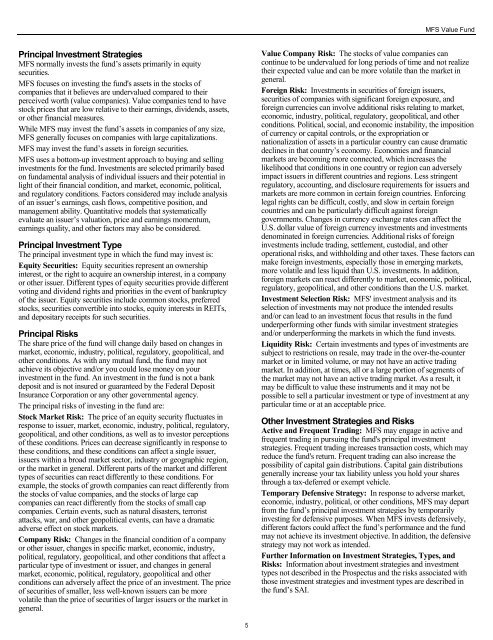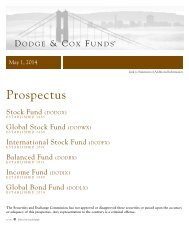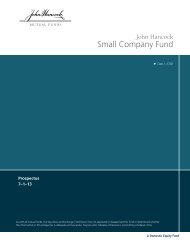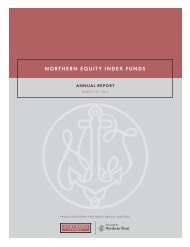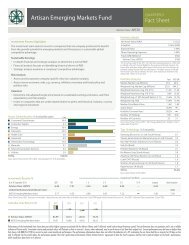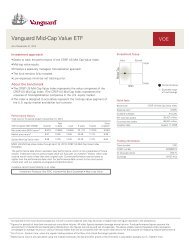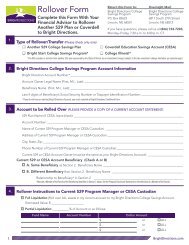EIF Prospectus - Bright Directions
EIF Prospectus - Bright Directions
EIF Prospectus - Bright Directions
Create successful ePaper yourself
Turn your PDF publications into a flip-book with our unique Google optimized e-Paper software.
MFS Value Fund<br />
Principal Investment Strategies<br />
MFS normally invests the fund‟s assets primarily in equity<br />
securities.<br />
MFS focuses on investing the fund's assets in the stocks of<br />
companies that it believes are undervalued compared to their<br />
perceived worth (value companies). Value companies tend to have<br />
stock prices that are low relative to their earnings, dividends, assets,<br />
or other financial measures.<br />
While MFS may invest the fund‟s assets in companies of any size,<br />
MFS generally focuses on companies with large capitalizations.<br />
MFS may invest the fund‟s assets in foreign securities.<br />
MFS uses a bottom-up investment approach to buying and selling<br />
investments for the fund. Investments are selected primarily based<br />
on fundamental analysis of individual issuers and their potential in<br />
light of their financial condition, and market, economic, political,<br />
and regulatory conditions. Factors considered may include analysis<br />
of an issuer‟s earnings, cash flows, competitive position, and<br />
management ability. Quantitative models that systematically<br />
evaluate an issuer‟s valuation, price and earnings momentum,<br />
earnings quality, and other factors may also be considered.<br />
Principal Investment Type<br />
The principal investment type in which the fund may invest is:<br />
Equity Securities: Equity securities represent an ownership<br />
interest, or the right to acquire an ownership interest, in a company<br />
or other issuer. Different types of equity securities provide different<br />
voting and dividend rights and priorities in the event of bankruptcy<br />
of the issuer. Equity securities include common stocks, preferred<br />
stocks, securities convertible into stocks, equity interests in REITs,<br />
and depositary receipts for such securities.<br />
Principal Risks<br />
The share price of the fund will change daily based on changes in<br />
market, economic, industry, political, regulatory, geopolitical, and<br />
other conditions. As with any mutual fund, the fund may not<br />
achieve its objective and/or you could lose money on your<br />
investment in the fund. An investment in the fund is not a bank<br />
deposit and is not insured or guaranteed by the Federal Deposit<br />
Insurance Corporation or any other governmental agency.<br />
The principal risks of investing in the fund are:<br />
Stock Market Risk: The price of an equity security fluctuates in<br />
response to issuer, market, economic, industry, political, regulatory,<br />
geopolitical, and other conditions, as well as to investor perceptions<br />
of these conditions. Prices can decrease significantly in response to<br />
these conditions, and these conditions can affect a single issuer,<br />
issuers within a broad market sector, industry or geographic region,<br />
or the market in general. Different parts of the market and different<br />
types of securities can react differently to these conditions. For<br />
example, the stocks of growth companies can react differently from<br />
the stocks of value companies, and the stocks of large cap<br />
companies can react differently from the stocks of small cap<br />
companies. Certain events, such as natural disasters, terrorist<br />
attacks, war, and other geopolitical events, can have a dramatic<br />
adverse effect on stock markets.<br />
Company Risk: Changes in the financial condition of a company<br />
or other issuer, changes in specific market, economic, industry,<br />
political, regulatory, geopolitical, and other conditions that affect a<br />
particular type of investment or issuer, and changes in general<br />
market, economic, political, regulatory, geopolitical and other<br />
conditions can adversely affect the price of an investment. The price<br />
of securities of smaller, less well-known issuers can be more<br />
volatile than the price of securities of larger issuers or the market in<br />
general.<br />
Value Company Risk: The stocks of value companies can<br />
continue to be undervalued for long periods of time and not realize<br />
their expected value and can be more volatile than the market in<br />
general.<br />
Foreign Risk: Investments in securities of foreign issuers,<br />
securities of companies with significant foreign exposure, and<br />
foreign currencies can involve additional risks relating to market,<br />
economic, industry, political, regulatory, geopolitical, and other<br />
conditions. Political, social, and economic instability, the imposition<br />
of currency or capital controls, or the expropriation or<br />
nationalization of assets in a particular country can cause dramatic<br />
declines in that country‟s economy. Economies and financial<br />
markets are becoming more connected, which increases the<br />
likelihood that conditions in one country or region can adversely<br />
impact issuers in different countries and regions. Less stringent<br />
regulatory, accounting, and disclosure requirements for issuers and<br />
markets are more common in certain foreign countries. Enforcing<br />
legal rights can be difficult, costly, and slow in certain foreign<br />
countries and can be particularly difficult against foreign<br />
governments. Changes in currency exchange rates can affect the<br />
U.S. dollar value of foreign currency investments and investments<br />
denominated in foreign currencies. Additional risks of foreign<br />
investments include trading, settlement, custodial, and other<br />
operational risks, and withholding and other taxes. These factors can<br />
make foreign investments, especially those in emerging markets,<br />
more volatile and less liquid than U.S. investments. In addition,<br />
foreign markets can react differently to market, economic, political,<br />
regulatory, geopolitical, and other conditions than the U.S. market.<br />
Investment Selection Risk: MFS' investment analysis and its<br />
selection of investments may not produce the intended results<br />
and/or can lead to an investment focus that results in the fund<br />
underperforming other funds with similar investment strategies<br />
and/or underperforming the markets in which the fund invests.<br />
Liquidity Risk: Certain investments and types of investments are<br />
subject to restrictions on resale, may trade in the over-the-counter<br />
market or in limited volume, or may not have an active trading<br />
market. In addition, at times, all or a large portion of segments of<br />
the market may not have an active trading market. As a result, it<br />
may be difficult to value these instruments and it may not be<br />
possible to sell a particular investment or type of investment at any<br />
particular time or at an acceptable price.<br />
Other Investment Strategies and Risks<br />
Active and Frequent Trading: MFS may engage in active and<br />
frequent trading in pursuing the fund's principal investment<br />
strategies. Frequent trading increases transaction costs, which may<br />
reduce the fund's return. Frequent trading can also increase the<br />
possibility of capital gain distributions. Capital gain distributions<br />
generally increase your tax liability unless you hold your shares<br />
through a tax-deferred or exempt vehicle.<br />
Temporary Defensive Strategy: In response to adverse market,<br />
economic, industry, political, or other conditions, MFS may depart<br />
from the fund‟s principal investment strategies by temporarily<br />
investing for defensive purposes. When MFS invests defensively,<br />
different factors could affect the fund‟s performance and the fund<br />
may not achieve its investment objective. In addition, the defensive<br />
strategy may not work as intended.<br />
Further Information on Investment Strategies, Types, and<br />
Risks: Information about investment strategies and investment<br />
types not described in the <strong>Prospectus</strong> and the risks associated with<br />
those investment strategies and investment types are described in<br />
the fund‟s SAI.<br />
5


